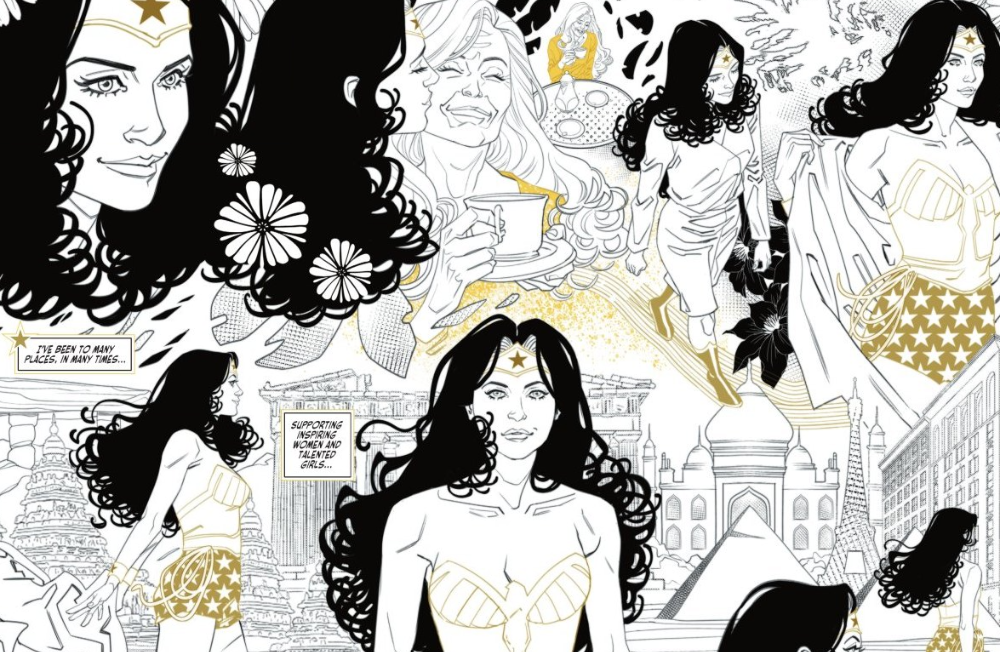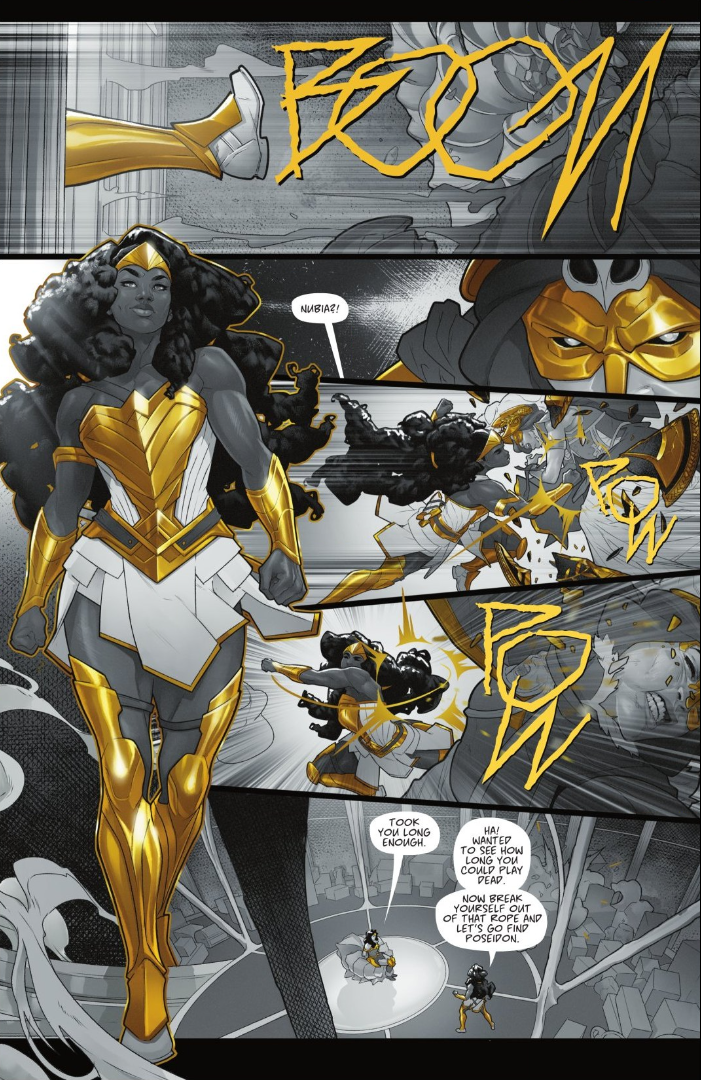Wonder Woman Black & Gold closes with strong stories and even stronger art
One misplaced contribution can’t derail incredible entries from the artists of Far Sector and DC’s Bombshells
Aux Features Wonder Woman Black & Gold
Starting last year, both Wonder Woman and Superman got their time to shine in color-limited anthologies. Building on the success of the popular and statue-launching Batman Black & White that ran almost 25 years ago, Wonder Woman Black & Gold is long overdue, and the final issue offers a prime opportunity to celebrate the character and some of the comics professionals that have brought her to life.
The series is only a half-dozen issues, with each issue offering a handful of stories, every one of them self-contained and driving at the core of what makes the character so compelling and popular after more than 80 years in print. With such such a robust legacy backing both the superhero and the book, it’s odd to see a lot of famous Wonder Woman contributors missing from the series, and even more disappointing to see that all six issues list mostly male contributors. That said, Wonder Woman Black & Gold #6 is one of the best entries in any of the three color-palette miniseries, and credit for that goes to the two female writers in the issue.
The first and last stories in this issue are by far the strongest, bright in tone and style both visually and narratively. Marguerite Sauvage wrote and illustrated opener “Role Model,” a story that casts Diana not just as a superhero, but a proud supporter and protector of girls and women who are changing the world for the better through compassion and activism. The double-page spreads, in particular, evoke the bright and feminine optimism of late ’80s and early ’90s Barbie, full of kinetic energy and the belief that girls can be and do anything they set their minds to.
Closing not just this issue, but the whole series, with Dr. Sheena Howard and Jamal Campbell’s “Fresh Air In Philly” was a masterstroke in editorial decision making. Campbell’s work on Far Sector is excellent, and the limited color palette of Wonder Woman Black & Gold creates a real showcase for his skill with character design, expressions, and action sequences. In this story, Nubia and Diana team up to save humans from Poseidon, who is furious at the pollution clogging his oceans and trying to poison all of humanity in return. It’s a timely (and sharply funny) comic, and the sisterly banter between Nubia and Diana is delightful.
“Lesson In Truth” and “Attack Of The 50-Foot Wonder Woman” are solid Wonder Woman stories that would likely stand out in any other anthology; it’s simply that they both pale a bit in comparison to “Role Model” and “Fresh Air In Philly.” Michael W. Conrad and Noah Bailey created “Lesson In Truth,” the story of a man so impacted by his childhood experience with Diana that it sends him into a spiral that almost destroys his life. Conrad has written something remarkable about forgiveness and second chances that can come after real consequences—a theme we don’t see as often as we should. Add to that Bailey’s work (very outside the norm for cape comics), and it forms a very unique read.
“Attack Of The 50-Foot Wonder Woman” is also about second chances, but Christos Gage, Kevin Maguire, and colorist Adriano Lucas deliver something much more akin to what readers might expect of a classic superhero story. It falls right in line with the best of DC’s animated shows: bright, poppy art and snappy dialog.
It would be unfair to call Liam Sharp’s “Prophet” the worst of the bunch, as it’s excellently executed, but as part of a well-crafted and modern anthology, it feels out of both place and time. Sharp’s stint at 2000AD (where he worked on Judge Dredd, among other books) is on full display, his art painterly and heavily detailed. It evokes Frank Frazetta and pulp adventures, which perfectly suits a story about a random man who has become a prophet foretelling not only certain doom, but also Diana’s arrival to thwart it. But in an anthology meant to celebrate one of the most famous female superheroes of all time, it feels tone deaf to cast this unnamed man in a role that very easily could have gone to a Cassandra figure—or Cassandra herself. And the way Sharp draws not only Diana but also her opponent Berchta is all pulp and no Wonder Woman; the focus is on their bodies, and even the muscle-bound Berchta is sexualized by both her clothing and poses. For many readers, especially young women who saw themselves represented and protected in Sauvage’s story just pages before, it can be a huge turn-off.
Sharp’s work does raise the question of who this book is for, which is a growing question in comics writ large, but especially superheroes. The wildly shifting tone makes it unclear what type of reader this series was crafted for. Many of the best stories focus on Diana’s capacity for both justice and forgiveness, striving to make the world safer and better for everyone. In contrast, the few tales about vengeance and violence feel very out of place and can interrupt the flow of the book; most were written by men. One of the strengths of anthology books is that they provide a remarkable opportunity to tell a variety of stories linked together, but if some of the contributions interrupt, distract, or even contradict the others, perhaps they don’t belong.

4 Comments
Another review from Caitlin where the only thing that matters is the gender of the writers. Yawn. Is it any wonder why the only work Caitlin can get is writing reviews no one reads or cares about for this crappy ghost of a website?
Is it any wonder that the 1940 Summer Olympics were cancelled due to the second Sino-Japanese War, postponed indefinitely due to World War II, and didn’t resume until 1948 in London after the war had ended?
Marston et. al. created Wonder Woman to rewrite how women were treated in stories. This review actually discusses why the gender of the writers matters, that the tone of the stories, and Diana’s approaches, changes radically based upon that point. That’s not a great approach to presenting a coherent set of stories about the same character.
And just to say it out loud — Perez’s contributions aren’t being thrown out, to name one critical example. But the critique being laid out here is a real and ongoing problem with writers for Diana, and it’s one worth calling out when it pops up.
DC doesn’t seem to know what to do with Diana. The run where she died and went on an adventure in the Valhalla was good, but writers have just been going in circles with her, telling the “meddling gods” and “find the lost island” stories over and over. Writers have her in too much of a box, afraid to show her making mistakes. Batman screws up all the time, and his stories are interesting!